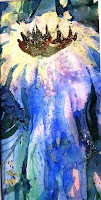

One of the largest fertility festivals of the ancient calendar, Eostra, falls on the spring equinox when day and night are in equal balance and life has returned in profusion.The Anglo-Saxon Goddess of sunrise and spring was known as Eostra or Eastre and her sacred month was called 'Eastremonath' - Moon of Eostre.
Like all the Christian church's moveable feasts, Easter shows it's pagan origin in a dating system based on the old lunar calendar.It is always the first Sunday after the first full moon after the Spring Equinox.The Christian festival wasn't called Easter until the Goddess's name was given to it in the late Middle Ages.
The Irish observed Easter on a different date from that of the Roman church, probably the original date of the festival of Eostre, until the Roman calendar was imposed in 632 A.D.
The most striking thing about the mythology of hares is the degree of commonality across the globe, there are long-spoken tales of hares from the Americas to the Far East, from Africa to Europe. The hare is embedded in the folk myths of our ancestors. It is associated in mythology with the Moon, the celestial skies and the Sun, with fertility, the dawn, cunning and bravery. There is evidence of hare mythology in ancient pottery, coins, seals, and hieroglyphics and in oral history. (In Egypt the hare symbolised the very essence of life itself: the hieroglyphic 'Wn', depicting a hare on top of a single blue-green ripple, means 'to exist'). Similar to the fact that most ancient cultures have a flood myth, most also seem to have hare mythology. What was it about the hare which led to this mythology? We will probably never know for sure, but the fact that wild hares lived in proximity to people, perform unique and uninhibited courtship dances, are extremely sexually active in the spring and are active at night, were all factors.

